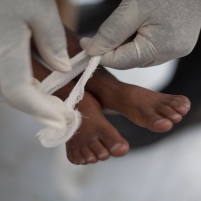Cholera Epidemic in Haiti Caused by U.N.
Tuesday, April 03, 2012
 Haiti cholera victim Clercilia Regis, 2, died a few minutes earlier November 10, 2010 (AP Photo: Ramon Espinosa)
Haiti cholera victim Clercilia Regis, 2, died a few minutes earlier November 10, 2010 (AP Photo: Ramon Espinosa)
Cholera has ravaged five percent of Haiti’s population, killing thousands. And the impoverished island country has the United Nations to blame.
Since the January 12, 2010, earthquake, more than 7,000 Haitians have died from the world’s worst recent outbreak of cholera—a disease that never existed on the island until UN peacekeeping troops showed up to help in the recovery.
The epidemic began after faulty sanitation at a UN base resulted in untreated sewage spilling into a nearby river, which many Haitians relied on for drinking and bathing. Epidemiologists believe cholera was introduced by infected peacekeeping troops from Nepal, who arrived in Haiti in October 2010.
Officials at the base insisted at first that sanitation met international standards. But less than three weeks after the arrival of the Nepalese troops, the media discovered peacekeepers struggling to contain a sewage spill, resulting in “black liquid” flowing directly into the river.
Dr. Renaud Piarroux, an infectious diseases specialist and parasitologist from France, was the first scientist to trace the cholera outbreak to the U.N. base, but his conclusions were met with hostility. The Lancet, a leading medical journal, refused to publish his study. It wasn’t until May 2011 that United Nations experts confirmed that the Nepalese base was the original source of the cholera epidemic.
-Noel Brinkerhoff, David Wallechinsky
To Learn More:
In Haiti, Global Failures on a Cholera Epidemic (by Deborah Sontag, New York Times)
Remember Haiti? Cholera Cases Could Top 750,000 (by Noel Brinkerhoff, AllGov)
- Top Stories
- Unusual News
- Where is the Money Going?
- Controversies
- U.S. and the World
- Appointments and Resignations
- Latest News
- Trump to Stop Deportations If…
- Trump Denounces World Series
- What If China Invaded the United States?
- Donald Trump Has a Mental Health Problem and It Has a Name
- Trump Goes on Renaming Frenzy






Comments